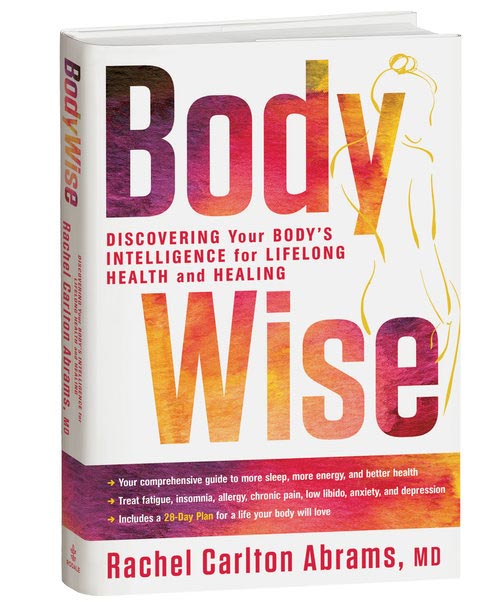Improving Chronic Pain With Your Mind and Heart
 It’s an understatement to say that chronic pain sucks. And requires trips to the doctor — and probably the pharmacy. But what if you could treat chronic pain with some quiet time on your meditation pillow? That’s exactly one of the things that Dr. Rachel Carlton Abrams, board-certified physician in family and integrative medicine, prescribes in her new book Bodywise: Discovering Your Body’s Intelligence for Lifelong Health and Healing. And we’re lucky enough to be sharing an excerpt on just that from her book today!
It’s an understatement to say that chronic pain sucks. And requires trips to the doctor — and probably the pharmacy. But what if you could treat chronic pain with some quiet time on your meditation pillow? That’s exactly one of the things that Dr. Rachel Carlton Abrams, board-certified physician in family and integrative medicine, prescribes in her new book Bodywise: Discovering Your Body’s Intelligence for Lifelong Health and Healing. And we’re lucky enough to be sharing an excerpt on just that from her book today!

Improving Chronic Pain with Your Mind and Heart
Meditation or prayer can be very effective for reducing chronic pain of all types, as well as symptoms of depression or anxiety. As is the case with almost all chronic health conditions, the practice of mindfulness-based stress reduction can substantially reduce pain symptoms, as can transcendental meditation (TM). Just 20 minutes of daily meditation can make a substantial difference in pain. The power of our minds, hearts, and imaginations to shift our physiologies, including inflammation, in beneficial ways, is truly amazing. Much of the research on pain reduction has been conducted on mindfulness meditation, but a number of studies showed similar benefits from other activities, such as prayer, meditative yoga and walking in nature. Finding these moments of peace creates a pathway where you can make decisions and choose your life independent of the pain, instead of always under the cloud of it.
When I work with patients in my office, I often use a meditative visualization exercise to help them understand and relieve their pain. (See “Exercise: Shifting Pain” below.) When you use your body intelligence to communicate with your pain, and then to begin to soothe it, remarkable things can happen. You may identify an emotional situation or relationship that needs to shift. You may find a visualization that helps you reduce your suffering. Or, you may gain insight into the physiology of the pain itself. You can use the “Shifting Pain” exercise to help you gain the ability to reduce your pain at will, when necessary.
Given what we know about the power of visualization, I am sure that we are actually reducing the inflammatory mediators at the site of the pain. Remember to check in with your pain more regularly for guidance on how to feel better. Be sure to note if your pain has any messages for you. I work with patients with significant physical pain who, by focusing on the pain sensation and doing visualization exercises, can substantially reduce the experience of their pain.
Use your own body wisdom to guide you to the practices, practitioners, treatments, supplements, exercises, dietary changes, and testing that seem most useful to you, and I am confident that you can find some relief from your chronic pain. Sometimes, our bodies whisper in a language we can barely understand and, at other times, they seem to yell with persistent intensity — as in the case with chronic pain. Listen to trusted sources, and most important, your own body, and let it guide you to a life with less pain and more freedom.
Exercise: Shifting Pain
- Close your eyes if you are able to listen to this exercise on our audio version at doctorrachel.com, in the “Books” section under BodyWise. For most of us, it is easier to focus inwardly when we are not distracted by what we see outwardly. Otherwise, it is fine to simply relax and read the exercise.
- Sit or lie in a comfortable position.
- Take three deep breaths. Breathe in through your nose, allowing your belly to expand, as in the Belly Breathing exercise (which also has an audio version that can be found at the link above).
- Bring your awareness to each part of your body from your toes up to your head.
- Focus on an area of your body in which you feel pain.
- Notice the quality of the pain sensation. What type, size, density, temperature, and color is it?
- Ask your pain, “What are you trying to tell me?” and listen for or observe a response. After several breaths, move to the next step.
- Find a relieving visualization for your pain, for example, if the pain is burning and red, imagine that you have a powerful vessel of cooling water that you slowly pour over it. See if you are able to pour enough to begin to cool the pain. If your pain is cold and solid, see if you can warm and liquefy it. If it is dense and hard, see if you can dissolve it or blow wind through it or pull it apart, like a knot of rope. If it is moving like a snake or liquid mercury, find a container to catch it and contain it. Continue to breathe deeply into the area of your pain while you do your relieving visualization. If the pain shifts shapes, shift your relieving strategy.
- Minimize the size of your pain by imagining that you are gathering it into a box or container, withdrawing it from the far corners of your body with your hands, a tool or a vacuum cleaner. You can even close the container and lock it. Feel the pain reduce in size and intensity.
- Now, take a moment to focus on an area of your body that is not in pain. Breathe into the relaxation and flow that’s present in that area.
- Take a deep breath and give thanks to your body for speaking with you.
What chronic pain do you struggle with? How did this exercise help? —Dr. Rachel Carlton Abrams
Reprinted from “Bodywise” by Dr. Rachel Carlton Abrams. Copyright © 2016. By permission of Rodale Books. Available wherever books are sold.
